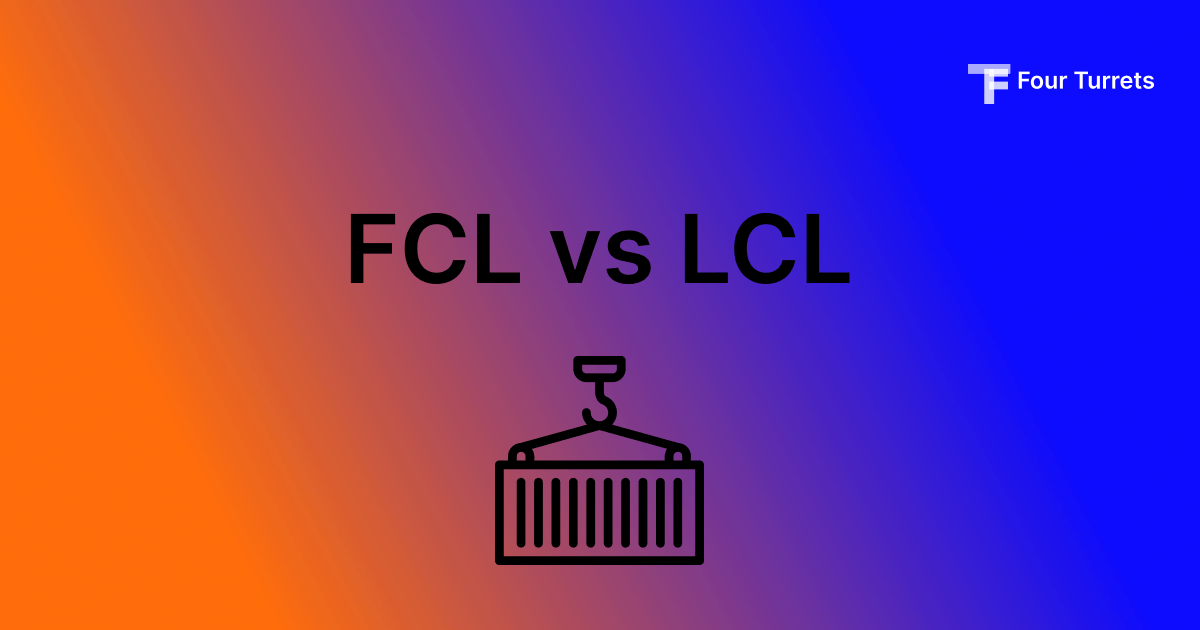When you work with physical goods movement, you often hear words like sending LCL or FCL shipments. Generally, international freight forwarding companies use containers to ship goods across borders. Warehouse management, supply chain management teams, and even traders measure their space requirements based on the container capacities.
There are numerous terms used in shipping methods in the supply chain industry to make trade between boundaries easy. Air Freight, Sea Freight, or local transportation, depending on how fast you want the goods, how far you want to send the goods, and how much space/weight the good has, you can use these container spaces.
Let’s find out what FCL and LCL are. Let’s understand in detail!
What is FCL?
FCL stands for full container load. It is a shipping term used in the field of logistics to denote a method where one shipper fills an entire container with goods. It is commonly used in ocean freight due to the efficiency and security it offers for the goods. While employing FCL, the shipper has exclusive use of the container, which means they do not have to share space with other parties. This arrangement can simplify the logistics process by reducing the handling and transit times associated with multiple consignments.
By using FCL, businesses can ensure that their cargo remains untouched from the point of loading until it reaches the destination port. This minimizes the risk of damage and loss, allowing for greater control over the goods being transported. Once the container arrives, it is unloaded and the contents are delivered to the final destination of the buyer. FCL is typically more cost-effective for exporters who need to transport large quantities of goods, as the cost per unit of cargo decreases with the volume transported.
Moreover, FCL may also offer faster transit times and a reduced likelihood of delays since the container is directly routed to its destination without the need for intermediate stops or transfers. The convenience and reliability of FCL make it a preferred choice for many businesses involved in international trade.
Note: many businesses ask their buyers to go with an FCL MOQ (minimum order quantity) to ensure rapid shipping times and flexibility.
What is LCL?
LCL stands for Less than container load. This typically refers to a shipping method where a smaller quantity of cargo from different suppliers is consolidated into a single container. This method allows businesses to ship smaller amounts of goods or goods that do not fulfill the cubic meter requirements to fill a container. It gives the flexibility to ship smaller quantities while optimizing costs and efficiency. Smaller businesses would benefit from the same for managing inventory and meeting varying market demands.
The LCL approach is advantageous for small and medium-sized enterprises (SMEs) that operate on tight budgets and low-volume shipments. These businesses can take advantage of economies of scale by opting for the LCL shipment method. Costs associated with shipping, such as freight rates and handling fees, are shared among multiple shippers, making it a cost-effective solution. Additionally, LCL shipments are handled with improved frequency, leading to faster turnaround times compared to full container loads.
However, LCL shipping does have its drawbacks. As the cargo is mixed with other shipments, there is a higher risk of damage or loss, and difficulties or time delays in the customs clearance processes. Moreover, LCL shipments need thorough coordination and meticulous documentation to ensure proper handling and delivery of the goods.
Overall, LCL shipping plays a crucial role in the global logistics and supply chain network, providing flexibility and cost-efficiency for businesses of various scales. Despite its challenges, it remains a popular choice for managing dynamic market needs and reducing shipping expenses.
Note: you might need to declare if you are shipping dangerous goods in an LCL shipment by ocean freight. This should help the forwarder manage your goods in a way that does not harm other part loads within the container.
LCL vs FCL Shipment
Selecting the right shipping option between LCL and FCL is a crucial decision a business would make to build a strong supply chain process within the organization or for its clients. Each method offers its unique advantages and disadvantages.
You can identify your per-container loads and fulfill your shipping needs by using a full 20-foot container or a 40-foot container as well. But, if you have certain items that can be shipped with other teams with partial container loading, LCL would be the best solution.
In LCL container shipping, loads from various businesses are consolidated into one container. The time taken for this might vary depending on the orders your forwarding agent might have on their hand in that time frame. LCL offers you cost-effectiveness in the market. But, due to multiple types of loads in the container, your cargo might face an issue in obtaining security while in transit. Make sure to use proper packaging.
On the other hand, FCL helps you have more control over the shipment as your goods will occupy the entire container. For high-volume shipments, LCL may fail. On top of that, a full container load is best to save time and energy.
In conclusion, FCL shipping is a better option if you have more load to ship. But, on the other hand, LCL might become more economical for smaller shipments. Assess our business needs and risks involved in the shipment and ship FCL or LCL depending on these factors.



